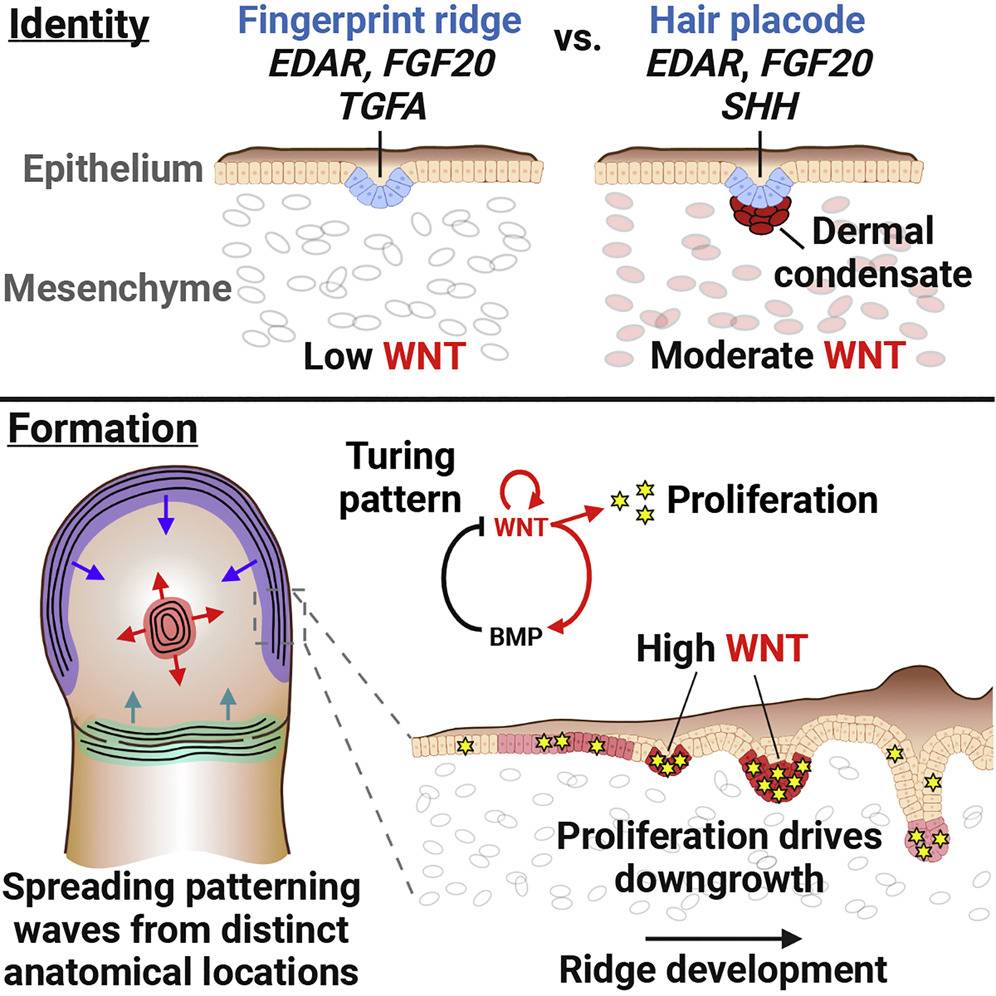Scientists from Edinburgh have solved the mystery behind the formation and variation in fingerprint patterns. Fingerprints are complex patterns, unique to every individual, and are determined before birth. The researchers from the University of Edinburgh unravel the molecular and cellular mechanisms underlying fingerprint ridge formation and their intricate arrangements. Fingerprint ridges are found to be epithelial appendages similar to hair follicles (HF), both structurally and molecularly, but lack the mesenchymal components and extended downgrowth of HF. The underlying Turing reaction-diffusion system establishes the spatial patterning of fingerprints. The Turing reaction-diffusion system is based on signaling between EDAR, WNT, and inhibitory BMP pathways. The authors report that ridge formation from variable sites, which are anatomically different, is the determining factor for the type of fingerprint pattern in humans-arch, loop, and whorl.
Fingerprints and the mystery of its pattern formation and variation

Humans and other climbing species are known to possess fine parallel ridges called dermatoglyphs that cover the skin of the palms and soles. The ridges provide a better grip and aid in discriminating between textures. Dermatoglyphs run almost transversely along two-thirds of the digits but form complex and unique patterns, fingerprints, at the distal tips. This pattern is prenatally determined and has been used as a biometric tool since the early nineteenth century. While each individual is said to have a unique spatial arrangement of fingerprint patterns, these patterns can be mostly grouped as arch, loop, and whorl.
Epithelial primary ridges formed around week 13 in the gestation period, are the building blocks of fingerprint pattern formation and variation. Scientists have known that these fingerprint-characterizing primary ridges exhibit downward growth, and over the next few weeks, secondary ridges are formed and result in a corrugated surface. However, the underlying mechanisms resulting in this spatial patterning were yet to be discovered until the authors unraveled the mystery. Previous existing theories based on intercellular signaling and simple mechanical deformation of epithelium have been proposed, which were not adequate. The authors in this study have shown that fingerprint ridges undergo a pruned version of the HF developmental mechanisms. The patterning is shown to be produced by a Turing reaction-diffusion system.
The rationale for mystery solving
Dermatoglyphs are only found in the volar skin. The rest of the skin has hair follicles(HF). These follicles start forming at the embryonic stage and exhibit extended tubular downgrowth aided by several signaling pathways. Given the similar downgrowths exhibited both in primary ridges and HF, the authors looked for similarities in cells from both these locations. The results revealed that three molecules, namely, WNT, EDAR, and BMP, involved in different signaling pathways were present in both sites. These pathways are intricately involved in the development of HF over the entire gestation period.
Turing patterns and Turing reaction-diffusion systems
Pattern formation in Biology has been an area of interest for quite some time, and understanding the mechanisms behind these patterns has eluded scientists. Alan Turing, a mathematician, in his seminal paper, proposed the model for pattern formation in several biological and chemical systems using reaction-diffusion systems. The Turing mechanism involves long-range inhibition and short-range activation, which has been previously proposed for hair follicle spacing, including the WNT signaling pathway. Patterns arising out of diffusive instabilities in the homogeneous reaction-diffusion system are the Turing patterns.
Signaling pathways determine fingerprint ridges
Experiments revealed that WNT signaling drives the proliferating downgrowth of the primary ridges. The WNT pathway activates the production of EDAR, which further enhances WNT signaling. On the other hand, BMP has been shown to have inhibitory effects. This fits well with the long-range inhibition and short-range activation under the Turing reaction-diffusion system, as BMP is broadly detected throughout the ridges and inter ridges region of the volar skin. The authors also show that the interplay between the WNT and BMP pathways results in the spacing between the ridges.
As a next step, the authors tweaked the molecule numbers in mice and observed that dialing the numbers up or down resulted in different patterns. It is important to note that mice do not have fingerprints but have striped ridges in their toes. The patterns were observed in these ridges. The authors find that increasing EDAR results in spaced-out ridges, while a decrease in EDAR reduces the stripes to spots. BMP, as it is inhibitory to the production of EDAR, exhibited the exact opposite trend.
The long-range inhibition and short-range activation result in this change between stripes-to-spots in Turing reaction-diffusion systems. As an obvious next step, the authors simulated a Turing pattern spreading from three initiation sites for the ridges, which were previously known, using computer models. The authors show that ridge initiation from these variable sites gives rise to unique fingerprint patterns. The authors tweaked the relative location, timing, and angle of these initiation points to arrive at the three kinds of patterns, viz, arch, loop, and whorl.
Conclusion
In this study, the authors solve the mystery underlying pattern formation in fingerprints. The authors show that early fingerprint ridges are similar to HF downgrowths and involve the same signaling pathways. These early ridges, while initiating from variable sites and under the influence of the interplay between the signaling pathways, give rise to the unique fingerprint patterns we all have. The authors caution that there could be more inhibitory players other than BMP. This is indeed a remarkable finding that solves the long-standing mystery of unique patterns in fingerprints.
Article Source: Reference Paper 1 | Reference Paper 2 | Reference Article
Learn More:
Top Bioinformatics Books ↗
Learn more to get deeper insights into the field of bioinformatics.
Top Free Online Bioinformatics Courses ↗
Freely available courses to learn each and every aspect of bioinformatics.
Latest Bioinformatics Breakthroughs ↗
Stay updated with the latest discoveries in the field of bioinformatics.
Banhita is a consulting scientific writing intern at CBIRT. She's a mathematician turned bioinformatician. She has gained valuable experience in this field of bioinformatics while working at esteemed institutions like KTH, Sweden, and NCBS, Bangalore. Banhita holds a Master's degree in Mathematics from the prestigious IIT Madras, as well as the University of Western Ontario in Canada. She's is deeply passionate about scientific writing, making her an invaluable asset to any research team.







